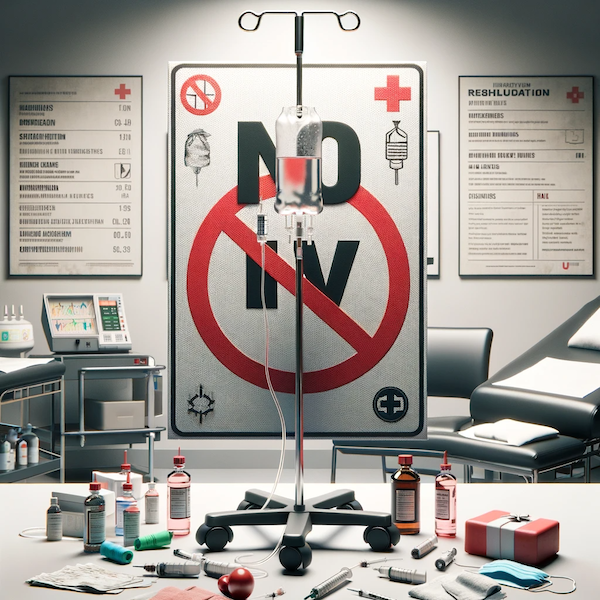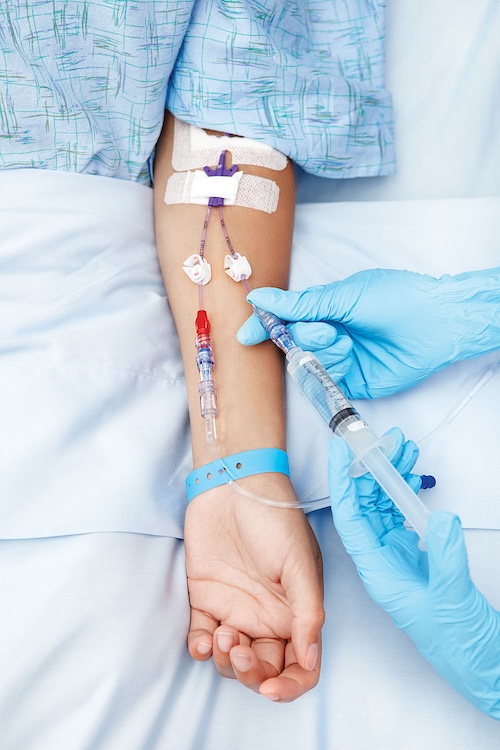
Are you wondering why the UFC banned IV hydration?
In this article, we examine the UFC IV ban, by going through what IV hydration is, why it was banned, how USADA tests for IV use, UFC fighters caught using IVs since its ban, and fighters accused.
Contents
What Is the UFC IV Rule?
The UFC IV rule imposed by USADA in 2015 and updated in 2019 hasn’t actually banned IV use. Instead, it introduced a restriction on volume and timing.
The UFC IV rule is: IV infusions over 100 mL per 12-hour period are prohibited at all times, except for those legitimately received in the course of hospital treatments, surgical procedures, or clinical diagnostic investigations.
If a fighter needs an IV for medical reasons, fighters must first apply for Therapeutic Use Exemption (TUE) and get approved. The TUE covers banned substances also.
Whenever a fighter receives an IV infusion, every detail of the infusion, such as IV substance, volume, time, etc., must be recorded in the medical documentation for USADA to verify.
The restriction to 100 mL per 12-hour period significantly limits IV use for UFC fighters, as this volume is insufficient for achieving the hydration levels athletes typically seek through IV therapy.
Why a 100ml IV per 12 hours is effectively a ban:
During the weight-cutting process, fighters may lose upwards of 20 lbs, primarily through water loss, over a period of 4-6 days during fight week.
This process involves manipulating water and sodium levels to achieve a state of rapid water weight loss, leading to significant dehydration.
Given the scale of fluid and electrolyte loss in such scenarios, a mere 100 mL of IV hydration is too minimal to effectively rehydrate the body or replenish the electrolytes lost during the intense weight-cutting phase.
For perspective, the amount of water manipulated during the weight-cutting process can be several gallons, making the 100 mL limit almost negligible in comparison.
As a result, the rule compels fighters to rely on oral hydration, drinking fluids with electrolytes, and nutrients over a longer period.
Supporting this, MMA coach Eugene Bareman said when commenting on Islam Makhachev’s illegal IV use, “You’ve just got to ask yourself if it’s only 100ml you’ve got to use for 12 hours, why would you even bother?”
UFC IV Ban: Why It Was Introduced (4 Reasons)

The UFC IV ban was introduced to prevent fighters from using IVs to mask performance-enhancing drugs (PEDs) and to discourage fighters from extreme weight-cutting via dehydration, as they no longer have the means to rapidly rehydrate with IV use.
Here’s a closer look at the 4 main reasons why the UFC IV ban was introduced:
1. Masking Performance-Enhancing Drugs (PEDs)
The UFC’s IV rule aims to prevent the misuse of IVs in doping, focusing on three main concerns:
- Blood Test Alteration: IVs can dilute blood, affecting key indicators like hematocrit levels, thus potentially masking blood doping or EPO use.
- Urine Dilution: By increasing the body’s fluid volume, IVs can dilute urine samples, reducing the concentration of PEDs and making them harder to detect.
- Accelerated Substance Clearance: IVs can also speed up the elimination of banned substances from the body, shortening the time frame in which they can be detected in doping tests.
If UFC fighters have knowledge of an upcoming test, they could time their IV fluid intake to coincide with drug testing schedules.
2. Enhanced Performance Through Increased Plasma Volume
This aspect is particularly significant, as it’s one of the reasons IV infusions or injections are included on the WADA Prohibited List.
Impact of Increased Plasma Volume
- Enhanced Endurance: An increase in plasma volume can improve cardiovascular performance and endurance. This is because a higher plasma volume can lead to better oxygen transport and more efficient removal of metabolic waste products from muscles.
- Reduced Fatigue: Enhanced plasma volume can delay the onset of fatigue during prolonged physical activity, giving a competitive advantage in endurance-based sports.
- Rapid Recovery: Increased plasma volume aids in quicker recovery post-exercise, allowing athletes to perform at a high level over consecutive days or events.
Note: IV infusions commonly increase the body’s plasma volume, which is primarily due to the electrolytes and fluids in the IV solution, such as saline, which add volume to the blood.
3. Rapid Rehydration
The UFC’s ban on IV use also aims to address the health risks associated with rapid rehydration following extreme weight cuts.
The Process and Risks of Rapid Weight Loss: Weight cutting, a common practice among fighters to qualify for a lower weight class, can be hazardous to health as it involves expelling large amounts of water weight in 4 to 6 days.
This process can lead to significant health risks, including electrolyte imbalances, reduced muscle strength, and impaired cognitive functions.
IV Rehydration: Prior to the ban, fighters relied on IV rehydration to quickly restore lost water and electrolytes, a process much faster than oral consumption.
This method allowed them to rapidly regain water and electrolytes after the official weigh-in, often leading to more extreme weight-cutting practices.
The knowledge that they could quickly rehydrate and recover encouraged fighters to push the limits of dehydration.
Impact on Health and Performance: While IV rehydration can rapidly restore fluid levels, it doesn’t negate the risks associated with drastic weight loss.
Moreover, it can take up to 72 hours for the body, especially the brain, to fully rehydrate after severe dehydration.
This delay can impact a fighter’s performance and health during the fight, even with early weigh-ins (moved from late afternoon to 9-11 am).
Some fighters who cut dangerous levels of water weight may not be at their optimal physical and mental condition when fighting, posing a risk to their safety.
This is still an issue in 2023, but the banning of IVs attempted to prevent UFC fighters from cutting dangerous amounts of water weight.
4. Dangers of IV Use
The UFC’s restriction on IV use is underpinned by significant health concerns associated with IV therapy.
According to USADA, the potential risks and complications of IV therapy include:
Infection and Cellulitis: The use of non-sterile equipment or improper administration can lead to infections or cellulitis, a painful skin infection that can spread rapidly.
Vein Inflammation and Thrombosis: IV therapy can cause inflammation of the vein walls, potentially leading to thrombosis, a dangerous condition where blood clots form in the veins.
Bleeding and Hematoma: Incorrect needle placement can cause bleeding or hematoma, where blood accumulates outside of the blood vessels.
Tissue Leakage: There’s a risk of the IV solution unintentionally leaking into surrounding tissues, causing irritation and swelling.
Air Embolism: If air enters the veins through the IV line, it can lead to an air embolism, a life-threatening condition.
Needle Stick Injuries: Healthcare providers administering IVs are at risk of needle stick injuries, which can transmit infections.
Electrolyte Imbalances: Inappropriately balanced IV solutions can lead to severe electrolyte imbalances, affecting the heart, muscles, and nervous system, and in extreme cases, can be fatal.
Former UFC fighters Vinny Magalhaes and Bristol Marunde suffered infections due to non-sterile IV lines.
These infections not only affected their performance but also posed a significant health risk. Both fighters suffered from a fever.
These examples, combined with the risks outlined by USADA, illustrate why the UFC has taken a firm stance on limiting IV use.
When Did the UFC Ban IV Hydration?
The UFC banned IV use (or limited it to 100ml infusions per 12 hours) in October 2015 after partnering with the United States Anti-Doping Agency (USADA) to implement a stringent anti-doping policy.
This move was part of a broader effort to ensure a fair and clean competition environment within the sport.
What Is Intravenous Hydration In MMA?

Intravenous (IV) hydration, also known as intravenous fluid therapy (IVF), is a medical procedure that involves administering fluids directly into the veins to rapidly treat dehydration.
This is typically done by inserting a cannula—a thin tube—into a vein, often in the arm, which is then connected to a bag of fluid.
Composition and Procedure: The fluid usually consists of sterile water mixed with essential electrolytes and nutrients. Common solutions include sodium chloride or lactated Ringer’s solution, often in one-liter (1000 ml) bags.
These electrolytes, such as sodium, potassium, and chloride, are crucial for maintaining fluid balance and ensuring proper muscle and nerve function. Sodium, in particular, helps increase fluid retention and stimulate intake.
Application in MMA/UFC: For MMA and UFC fighters, especially those recovering from the effects of dehydration due to intense weight-cutting practices, IV hydration is often used to quickly restore the balance of electrolytes lost through excessive sweating or rapid water weight loss.
The solution used in these cases typically has a higher concentration of electrolytes to effectively replenish the body’s needs.
Oral Rehydration vs. IV Rehydration: What’s the Difference?
When comparing oral rehydration to IV rehydration, the key difference lies in the method of delivery and the speed at which hydration and nutrient replenishment occur.
IV Rehydration
- Direct Delivery: IV rehydration involves administering fluids and nutrients directly into the bloodstream via a vein. This method bypasses the digestive system, allowing for immediate absorption.
- Rapid Effect: Because the fluids and nutrients are delivered directly into the bloodstream, they can be utilized by the body much faster. This makes IV rehydration a preferred method for quick recovery, especially after intense physical exertion like weight cuts in UFC fighters.
- Health Risks: Despite its efficiency, IV rehydration carries certain health risks, such as infection or complications from improper administration.
- Placebo Effect: While IV therapy provides rapid relief, it’s not always necessary for complete rehydration by fight time. The belief that IV is more effective could be more psychological, with fighters feeling better faster because they think the method is more efficient.
Oral Rehydration
- Digestive Process: Oral rehydration requires consuming fluids and nutrients by mouth. These substances then travel to the stomach and through the digestive system.
- Slower Absorption: The body needs time to digest and break down the nutrients, which are then absorbed into the bloodstream and transported to various organs. This process is slower compared to IV rehydration.
- Safety: Oral rehydration is generally safer than IV rehydration, as it carries a lower risk of complications associated with intravenous procedures.
In summary, while IV rehydration offers a faster and more direct method of fluid and nutrient replenishment, it comes with certain health risks.
On the other hand, oral rehydration is safer but slower, relying on the body’s natural digestive and absorption processes.
Finally, USADA believes “there is no convincing research to support the use of IV fluid administration prior to competition for performance enhancement, rehydration, dehydration prevention, or muscle cramp prevention.
American College of Sports Medicine consensus guidelines state, “IV fluids do not provide an advantage over drinking oral fluids and electrolytes.”
How Does USADA Test For IV Use?
The United States Anti-Doping Agency (USADA) employs sophisticated methods to detect unauthorized intravenous (IV) infusion use among UFC fighters.
Here’s an overview of the 3 primary techniques used:
1. Athlete Biological Passport (ABP) Monitoring: USADA utilizes the Athlete Biological Passport program, which tracks an athlete’s biological markers over time.
This method doesn’t look for specific banned substances but rather monitors changes in blood and urine markers that could indicate the use of prohibited methods, such as IV infusions.
Significant fluctuations in parameters like hematocrit or hemoglobin levels can raise red flags, suggesting possible blood manipulation through IV use.
2. Detection of IV Markers: In addition to the ABP, USADA sometimes employs direct detection techniques.
This involves testing for traces of substances commonly found in IV solutions, such as plasticizers.
Plasticizers are chemicals present in IV bags and tubing, and their detection in an athlete’s urine can be indicative of recent IV use.
However, this approach can be complex due to the variability in individual exposure to plasticizers.
3. Medical Documentation and Reporting: USADA requires athletes to report any medical treatment they receive, including IV infusions.
Athletes must provide comprehensive documentation for any legitimate medical use of IVs.
This documentation is scrutinized to ensure compliance with anti-doping rules. Failure to report or provide sufficient evidence for medically necessary IV use can lead to anti-doping violations.
Challenges in Monitoring IV Use: USADA likely focuses on testing for IV use between Friday weigh-ins and Saturday fights, a critical period for fighter rehydration.
Despite this targeted approach, the exact testing schedule remains undisclosed, potentially allowing some fighters to use IVs undetected.
This uncertainty, coupled with the possibility of fighters identifying and exploiting testing gaps, poses a challenge in fully enforcing the IV ban.
While the likelihood of IV use is reduced outside this period, ensuring complete compliance remains a complex task for USADA.
It’s highly likely that UFC fighters are still illegally using IVs of more than 100ml per 12 hours and getting away with it.
UFC Fighters Caught Using IV Hydration After the Ban

Since the UFC IV ban was introduced in October 2015, 2 UFC fighters have been caught rehydrating with IVs. They are:
- Paulo Costa (2017) – 6-Month Suspension (Announced 04/26/2019)
- B.J. Penn (2016) – 6-Month Suspension (Announced 06/27/2016)
Drawing on video evidence and additional supporting material, USADA concluded Paulo Costa underwent an intravenous infusion (IV) exceeding the 100 mL limit per 12-hour period following his weigh-in for UFC 212.
The IV administered to Costa contained allowed substances, including saline and stomach medication, but was done without the necessary Therapeutic Use Exemption (TUE).
In a similar incident, on November 3, 2017, after the weigh-in for UFC 217 in New York City, New York, Costa once again received an IV infusion that surpassed the permitted volume within a 12-hour window, also without securing a TUE.
Costa claimed that his IV infusions were to help him recover from the effects of weight-cutting prior to UFC 212 and 217.
UFC fighters have also been accused of using IV hydration post-ban:
- Islam Makhachev – Dan Hooker accused Makhachev of using intravenous (IV) therapy to rehydrate after weigh-ins for his title bout against Alexander Volkanovski at UFC 284
Dumb cunt thinks he can fly to Australia hire a nurse to give him an I.V and we won’t find out. Cheating dog.
— Dan Hangman Hooker (@danthehangman) February 13, 2023
However, no evidence has been put forward to suggest Islam Makhachev illegally used an IV infusion of more than 100ml per 12 hours.
Some UFC fighters have received exemptions for IV use:
- Donald Cerrone: Received a TUE for IV use due to his unique medical condition, where he lacks 50 feet of intestines and half of his stomach. Therefore, his body’s ability to rehydrate naturally is significantly slower compared to other athletes.
MMA IV Therapy: Have All MMA Promotions Banned IV Use?
Unlike the UFC, no other large MMA promotions have explicitly stated that IV use is banned or limited to 100 mL per 12-hour period.
However, ONE Championship imposes the same IV ban/limitation on its fighters. Through its partnership with International Doping Tests & Management (starting August 26, 2022), which adheres to the World Anti-Doping Agency (WADA) Code, ONE Championship imposes restrictions on IV use.
The WADA Code limits IV infusions and/or injections to 100 mL per 12-hour period, except under specific medical exemptions.
Professional Fighters League (PFL) has partnered with USADA for its anti-doping program.
Given USADA’s alignment with WADA’s standards, it’s reasonable to infer that PFL also adheres to the same restrictions on IV use as the UFC.
Bellator doesn’t have an IV ban/limit on its fighters. Bellator isn’t partnered with an anti-doping agency, so its fighters are only tested during fight week by the State Athletic Commissions where events are held.
M1 Global is associated with the International Mixed Martial Arts Federation (IMMAF), which adheres to the World Anti-Doping Agency (WADA) Code.
While direct information about M1 Global’s specific policies on IV therapy isn’t readily available, their association with IMMAF suggests a possible alignment with WADA’s standards, which include limitations on IV use.
In summary, while the UFC, PFL, and ONE Championship have clear policies aligning with WADA’s guidelines on IV therapy, other major MMA promotions like RIZIN FF, KSW, and M1 Global have less transparent policies.
To Conclude
The UFC’s IV ban, implemented in October 2015 with USADA’s support, primarily aims to prevent the use of IVs for masking performance-enhancing drugs and to discourage extreme weight-cutting practices.
This rule restricts IV infusions to 100 mL per 12-hour period, effectively limiting their use in rapid rehydration and performance enhancement.
The ban addresses health risks associated with both rapid weight loss and IV therapy itself, including severe dehydration, infections, and electrolyte imbalances.
Despite enforcement efforts through biological passport monitoring and detection of IV markers, a strict testing schedule hasn’t been implemented or isn’t documented.
This means there’s a possibility that UFC fighters are still illegally using IVs without being caught.




